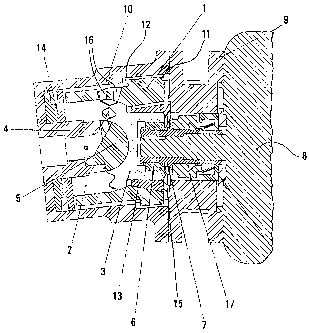Une partie des informations de ce site Web a été fournie par des sources externes. Le gouvernement du Canada n'assume aucune responsabilité concernant la précision, l'actualité ou la fiabilité des informations fournies par les sources externes. Les utilisateurs qui désirent employer cette information devraient consulter directement la source des informations. Le contenu fourni par les sources externes n'est pas assujetti aux exigences sur les langues officielles, la protection des renseignements personnels et l'accessibilité.
L'apparition de différences dans le texte et l'image des Revendications et de l'Abrégé dépend du moment auquel le document est publié. Les textes des Revendications et de l'Abrégé sont affichés :
| (12) Brevet: | (11) CA 2501161 |
|---|---|
| (54) Titre français: | BOITIER INTERNE POUR MACHINES A PISTON ROTATIF |
| (54) Titre anglais: | INNER HOUSING FOR ROTARY PISTON MACHINES |
| Statut: | Périmé et au-delà du délai pour l’annulation |
| (51) Classification internationale des brevets (CIB): |
|
|---|---|
| (72) Inventeurs : |
|
| (73) Titulaires : |
|
| (71) Demandeurs : |
|
| (74) Agent: | SMART & BIGGAR LP |
| (74) Co-agent: | |
| (45) Délivré: | 2010-11-23 |
| (86) Date de dépôt PCT: | 2003-08-04 |
| (87) Mise à la disponibilité du public: | 2004-02-19 |
| Requête d'examen: | 2008-07-15 |
| Licence disponible: | S.O. |
| Cédé au domaine public: | S.O. |
| (25) Langue des documents déposés: | Anglais |
| Traité de coopération en matière de brevets (PCT): | Oui |
|---|---|
| (86) Numéro de la demande PCT: | PCT/DE2003/002632 |
| (87) Numéro de publication internationale PCT: | WO 2004015245 |
| (85) Entrée nationale: | 2005-04-04 |
| (30) Données de priorité de la demande: | ||||||
|---|---|---|---|---|---|---|
|
L'invention concerne une machine à piston rotatif comportant une enveloppe interne (1) et des rotors (2, 3) dont les axes forment un angle, cette conception permettant de compenser les tolérances de fabrication et de réduire les pertes d'interstices inhérentes à de telles machines.
The invention relates to the rotary piston machine with an inner housing
(1) and rotors (2, 3), the axes of which are disposed at an angle to one
another in order to
equalize manufacturing tolerances and to reduce gap losses of such machines.
Note : Les revendications sont présentées dans la langue officielle dans laquelle elles ont été soumises.
Note : Les descriptions sont présentées dans la langue officielle dans laquelle elles ont été soumises.

2024-08-01 : Dans le cadre de la transition vers les Brevets de nouvelle génération (BNG), la base de données sur les brevets canadiens (BDBC) contient désormais un Historique d'événement plus détaillé, qui reproduit le Journal des événements de notre nouvelle solution interne.
Veuillez noter que les événements débutant par « Inactive : » se réfèrent à des événements qui ne sont plus utilisés dans notre nouvelle solution interne.
Pour une meilleure compréhension de l'état de la demande ou brevet qui figure sur cette page, la rubrique Mise en garde , et les descriptions de Brevet , Historique d'événement , Taxes périodiques et Historique des paiements devraient être consultées.
| Description | Date |
|---|---|
| Le délai pour l'annulation est expiré | 2023-02-06 |
| Lettre envoyée | 2022-08-04 |
| Lettre envoyée | 2022-02-04 |
| Lettre envoyée | 2021-08-04 |
| Inactive : COVID 19 - Délai prolongé | 2020-07-16 |
| Représentant commun nommé | 2019-10-30 |
| Représentant commun nommé | 2019-10-30 |
| Inactive : Lettre officielle | 2012-08-14 |
| Accordé par délivrance | 2010-11-23 |
| Inactive : Page couverture publiée | 2010-11-22 |
| Préoctroi | 2010-09-03 |
| Inactive : Taxe finale reçue | 2010-09-03 |
| Un avis d'acceptation est envoyé | 2010-04-28 |
| Lettre envoyée | 2010-04-28 |
| Un avis d'acceptation est envoyé | 2010-04-28 |
| Inactive : Approuvée aux fins d'acceptation (AFA) | 2010-04-26 |
| Lettre envoyée | 2010-04-07 |
| Modification reçue - modification volontaire | 2010-02-18 |
| Inactive : Transferts multiples | 2010-01-20 |
| Inactive : Dem. de l'examinateur par.30(2) Règles | 2009-08-18 |
| Lettre envoyée | 2008-09-19 |
| Modification reçue - modification volontaire | 2008-08-07 |
| Requête d'examen reçue | 2008-07-15 |
| Exigences pour une requête d'examen - jugée conforme | 2008-07-15 |
| Toutes les exigences pour l'examen - jugée conforme | 2008-07-15 |
| Lettre envoyée | 2006-05-05 |
| Inactive : Correspondance - Transfert | 2006-04-13 |
| Inactive : Transfert individuel | 2006-04-04 |
| Inactive : Lettre de courtoisie - Preuve | 2005-06-28 |
| Inactive : Page couverture publiée | 2005-06-23 |
| Inactive : Notice - Entrée phase nat. - Pas de RE | 2005-06-21 |
| Demande reçue - PCT | 2005-04-22 |
| Exigences pour l'entrée dans la phase nationale - jugée conforme | 2005-04-04 |
| Demande publiée (accessible au public) | 2004-02-19 |
Il n'y a pas d'historique d'abandonnement
Le dernier paiement a été reçu le 2010-04-23
Avis : Si le paiement en totalité n'a pas été reçu au plus tard à la date indiquée, une taxe supplémentaire peut être imposée, soit une des taxes suivantes :
Veuillez vous référer à la page web des taxes sur les brevets de l'OPIC pour voir tous les montants actuels des taxes.
Les titulaires actuels et antérieures au dossier sont affichés en ordre alphabétique.
| Titulaires actuels au dossier |
|---|
| ROBERT BOSCH GMBH |
| Titulaires antérieures au dossier |
|---|
| FELIX ARNOLD |